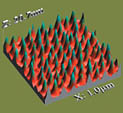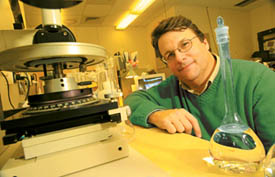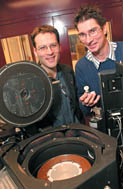It's a Nano World (Page 2)
 A graphic map showing an array of gold quantum dots, or gold 'nano islands,' created by Chemistry professor Bruce Lennox (right). |
 |

Engineering professor Andrew Kirk with Peter Grütter.
New Nanotools Facility
Thanks to a Canada Foundation for Innovation grant from the federal government and support from the provincial government and other sponsors, MIAM has a newly constructed $9 million nanotools centre, which opened officially in November. The facility includes a "clean room" filled with the high-tech machines needed to make nanomaterials - "clean" because it is constructed to eliminate unwieldy dust particles that might crush or otherwise impede those tiny objects of research. "It's a 21st-century machine shop," says Lennox. "These tools are pushing all the limits."
MIAM researchers also have a state-of-the-art microscope that can image and characterize individual atoms, and a supercomputer formed by a cluster of over 780 processors, with the power to run complex simulations.
Andrew Kirk, a professor in the Department of Electrical and Computer Engineering, is the co-director of the microfabrication lab in the nanotools facility. His research in photonics - the science of working with the energy in light and radiant energy, or the photons - is concerned with controlling and routing optical signals for telecommunications networks and high-speed computers.
"In order to do that," says Kirk, "we are trying to make very compact systems, which can be thought of as optical integrated circuits and analogous to electronic integrated circuits. To make these as compact and efficient as possible we need to be able to pattern structures which are the same scale as the wavelength of the light that we are using, which is of the order of one micron in the glass and silicon that we use. We need to be able to control the size of these structures with an accuracy of tens of nanometres, and so the new facility is very important."
Kirk says, in regard to basic science, "The facility allows us to collaborate with researchers in physics and chemistry in a way that was not previously possible at McGill, since we can now work together to make devices that solve real engineering problems based on new scientific principles." And he foresees links with a wide range of departments throughout the Faculty of Engineering and in biomedical research as well. "Before, we could not make the types of devices that would allow us to contribute effectively in the biomedical area, and it would not have been practical to get prototypes made elsewhere, due to the expense and the time delay."
Renaissance Science
Both Grütter and Lennox argue that nanotechnology has the potential to be a true renaissance science, developing new hybrid areas of research. Lennox's work in chemistry could have important applications in the life sciences, for instance. He takes elemental gold and reduces it, through chemical treatment, to spheres called quantum dots, about two nanometres in diameter. "These quantum dots in solution are an intense red, with properties completely different from gold," he explains. The dot has diamond-like facets, and chemicals can be deposited on this surface, which then change the dot's colour. Lennox is hoping to use this quality to develop a biosensor system, in which colour change could be used to indicate the presence of certain molecules - say, a certain type of DNA - in a solution.
But not all nano research focuses on tiny things alone. "Bulk nanomaterials" is how Robin Drew, Chair of Mining, Metals and Materials Engineering, describes one of his areas of research. "If you have better control at a nano-structural level, you can have more control over a structure's properties," he says. Much traditional metallurgy and materials science has involved working in the nano range, but without the trendy moniker. Heat treatment to strengthen aluminum alloys was discovered at the turn of the last century, but for years people didn't understand the phenomenon, although they knew it worked.
"The science behind it started in the 1950s and '60s," explains Drew, "but even then the processes involved manipulating atoms and then hoping that nature would produce what was wanted." Those days of trial and error may soon be numbered, as atomic probe technologies allow researchers to actually see atoms, map their configuration and dispersal, and understand what they are doing. "This way, when we make changes to the process, we can analyze their consequences. Then we can correlate this information with the atomic properties we've observed and manipulate atoms to control properties - such as the strength of alloys."


